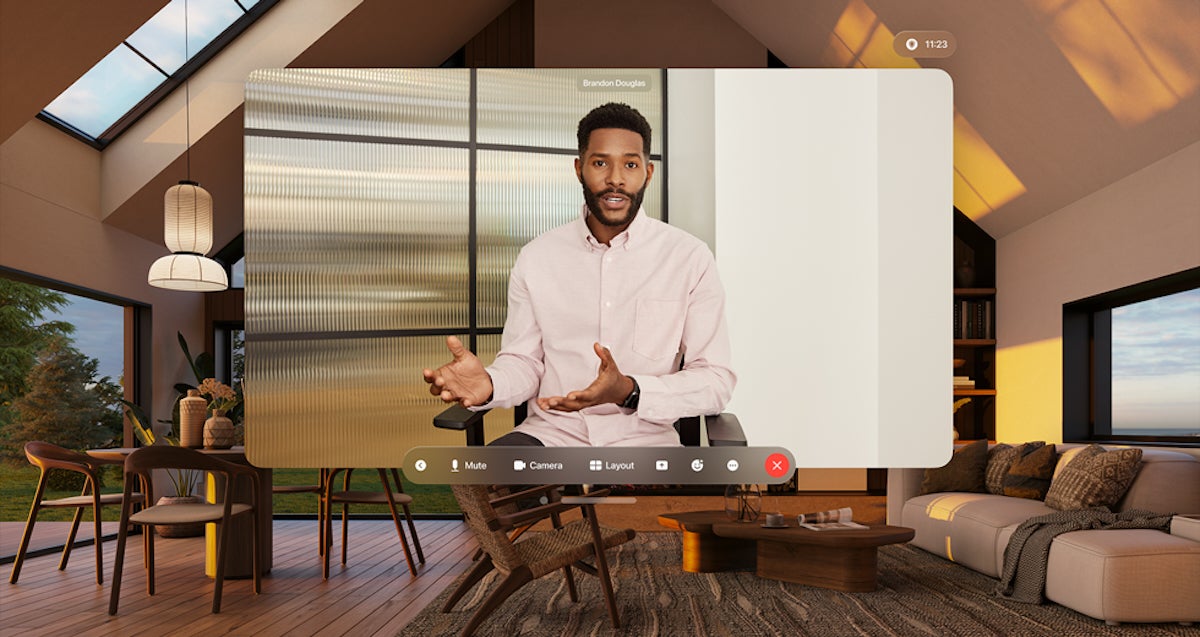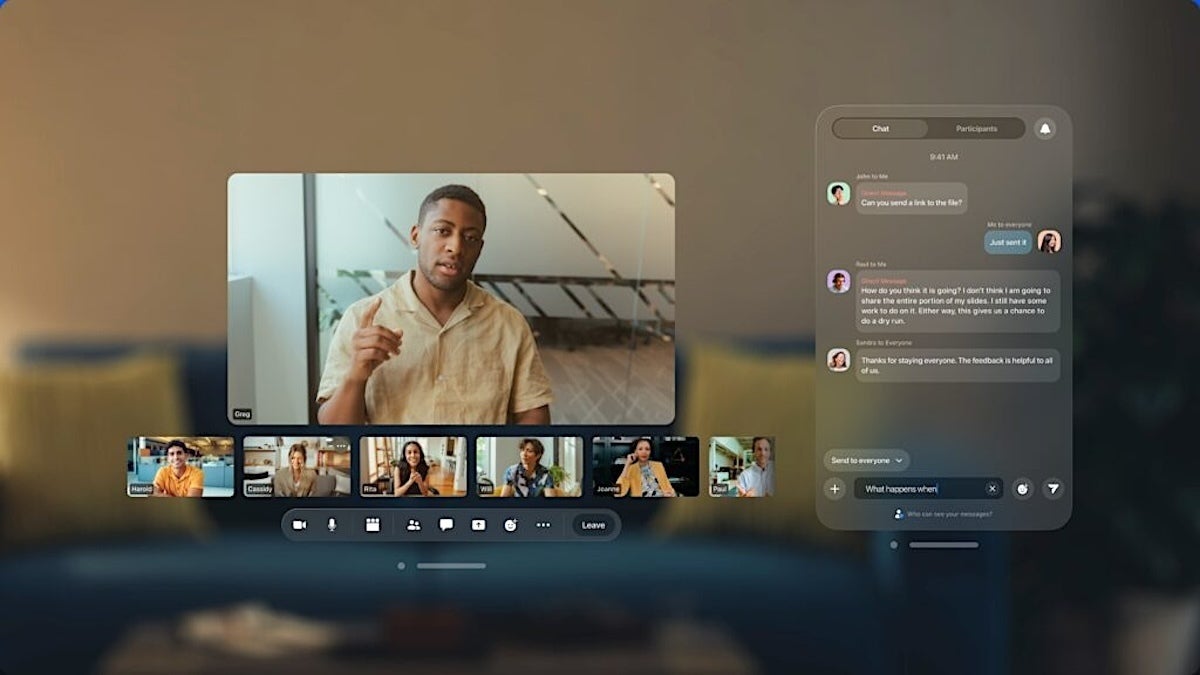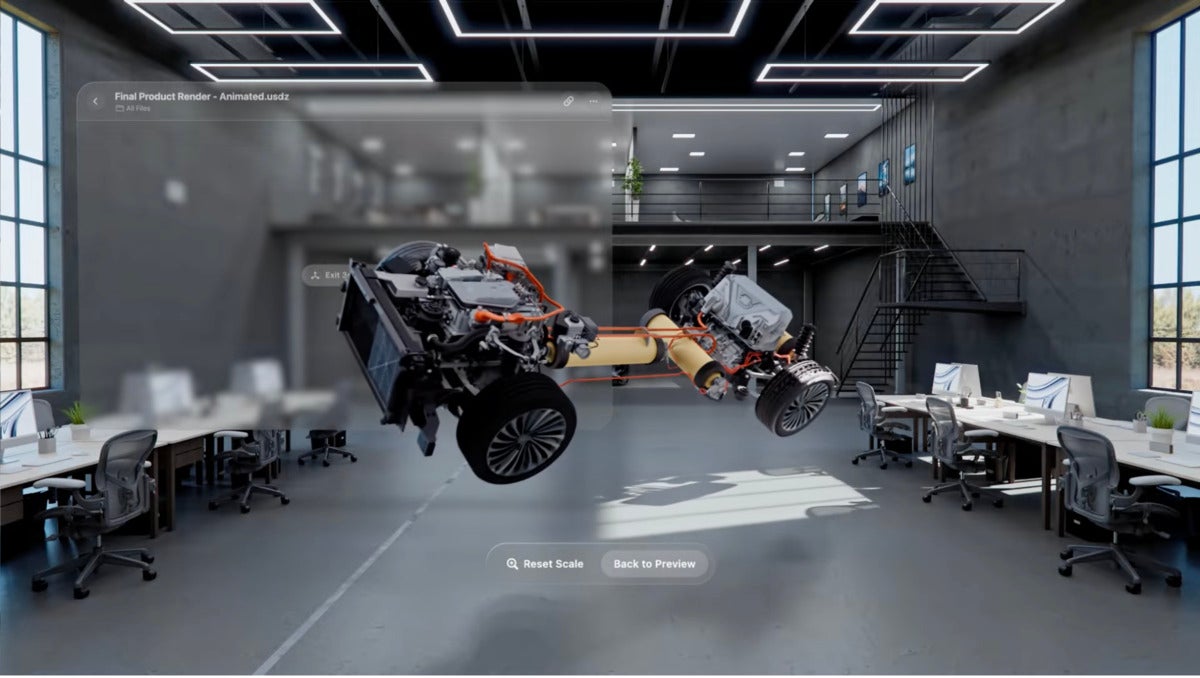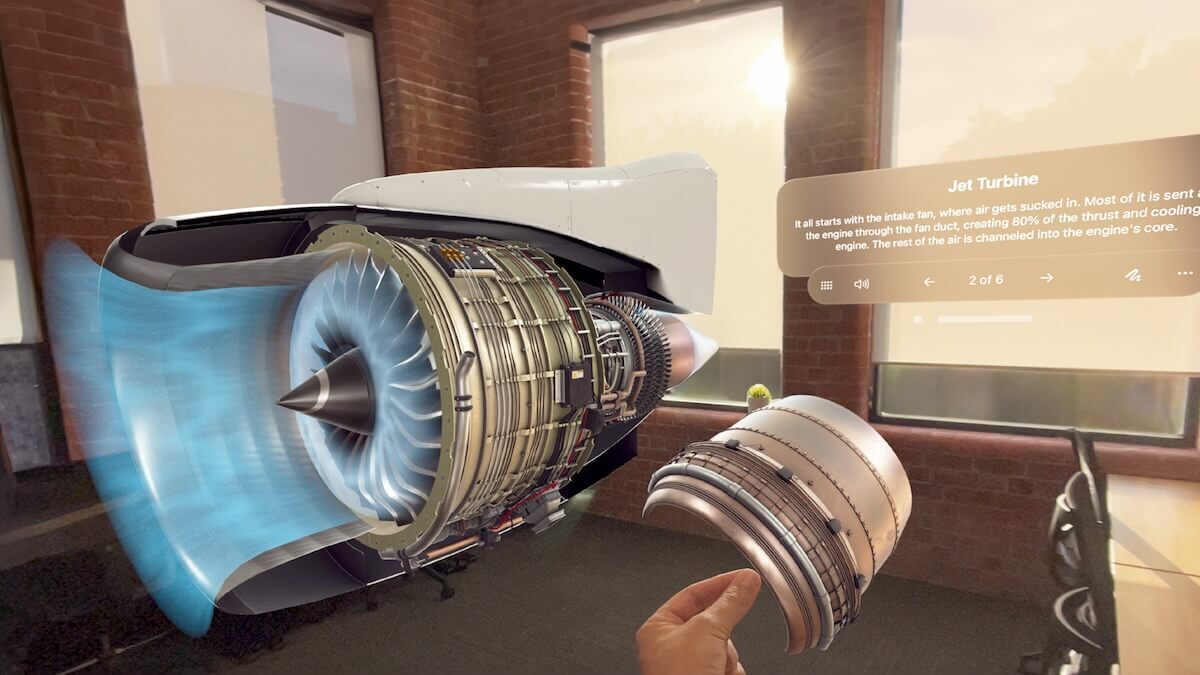Among the hundreds of native apps already available for Apple’s new Vision Pro headset, there’s already a range of tools focused on getting work done.
Microsoft, Cisco, and Zoom are among the software vendors that have already optimized their enterprise apps to function on Apple’s spatial computing device. They make use of the Vision Pro’s immersive virtual environments (to varying degrees) and large viewing space, promising new ways to view and interact with content or communicate with colleagues.
“Many early adopters will look to personal productivity as a key justification for buying an Apple Vision Pro, and there are some key native productivity apps available at launch — plus thousands more iPad apps that can run in the headset,” said Avi Greengart, founder and lead analyst at Techsponential.
Apple leaned on the Vision Pro’s consumer benefits in the run up to the Feb. 2 launch, but it clearly sees potential for work, too. (The recent addition of mobile device management (MDM) features for the device is perhaps inevitable, and serves as another indication of how Apple is catering to a business audience.)
In one sense, the Vision Pro is no different to any other computing platform in Apple’s portfolio. “Some people use Macs for Facebook, others design engine parts on them,” said Greengart. “Over time, I expect a full complement of productivity applications, tools, and services for VisionOS.”
Early enterprise uses for AR and VR have mostly centered around employee training and remote assistance — tasks that involve wearing the headset for short periods rather than a full day as a laptop replacement. While the Vision Pro has drawbacks similar to other headsets (battery life and weight, for instance), some new users are already pointing to its effectiveness as a work tool. They credit Apple with largely succeeding with the device’s eye and hand control interface, while the ability to access multiple apps and a large virtual monitor has advantages for productivity.
“Using the Apple Vision Pro with native apps arrayed around you and an Apple Silicon MacBook virtual display in the center feels like a productivity superpower,” said Greengart.
At the same time, it’s clearly a first-generation device, with a software ecosystem that is just now emerging. Anshel Sag, principal analyst at Moor Insights and Strategy, said the native apps aimed at productivity are “pretty effective,” but also feel like “pared down” versions of their PC counterparts, or “upgraded versions of the mobile apps enhanced with spatial awareness.”
Here are six of the notable digital work apps already available for the Vision Pro.
 Webex
Webex
Webex meetings can now be accessed using Apple's Vision Pro.
Cisco Webex and Zoom
Cisco promises an “immersive and intuitive meeting experience” with its native Webex app for visionOS. Users can access core Webex features, with the ability to join a meeting, arrange participant video feeds across their own screen, and create shared content windows. The app is optimized for the Vision Pro, with support for pinch and drag gestures that rely on the device’s hand- and eye-tracking technology.
During a meeting, Vision Pro users are represented by their digital Persona, which replicates face and hand movements.
 Zoom
Zoom
Zoom plans to add the ability to share and interact with 3D objects using the Vision Pro later this year.
Zoom provides a similar meeting experience with its native Vision Pro app, with Personas and access to Zoom’s Team Chat app. It also promises to let users share and interact with 3D objects using the Vision Pro in an update later this year.
Microsoft Office apps
Several Microsoft Office apps have been optimized for the Vision Pro, including Excel, PowerPoint, Word, and Teams.
The PowerPoint app marries well with the Vision Pro’s virtual environments, where users can practice their presentation just as they would present to an audience. Access to Excel spreadsheets is less immediately obvious, but one advantage cited by Microsoft is the ability to move graphs and charts between documents or Teams chats more efficiently.
In Teams, users can send chat messages, open calendars and access other Teams apps such as the Viva Engage social network, or join a Teams video meeting. Once in a meeting, a user can join with the Vision Pro persona. (Microsoft plans to add support for its own Mesh 3D environments later this year.)
 Microsoft
Microsoft
Teams users can join meetings using their Persona via the Vision Pro.
Microsoft is expected to release more native visionOS apps this year, but, for now, at the top of the wish list for many is Intune compatibility. Microsoft 365 users have complained that they are unable to access corporate apps using the Vision Pro without support for the enterprise device management platform.
Box
With its app for Vision Pro, Box promises to make content sharing more immersive, particularly when accessing 3D files that can be viewed and manipulated in virtual or mixed-reality environments.
Box offers up several use cases: manufacturers viewing product renderings on a virtual shop floor; construction firms accessing blueprints alongside project stakeholders; or retailers testing display window designs.
 Box
Box
Box allows Vision Pro users to view product renderings on a virtual shop floor, among other features,
Additionally, the Vision Pro’s “infinite desktop” — in other words, the ability to view several screens and apps at the same time — means 3D content can be displayed alongside other sources of information.
Adobe Lightroom
Adobe’s Lightroom video editing app is one of four native apps available for the Vision Pro; the Fresco sketch app, Behance social network, and generative AI tool Firefly have also gotten the spatial computing treatment.
The Lightroom app for visionOS functions much like the regular version of the app, with the ability to manipulate images on a large virtual screen using the Vision Pro inputs, as well as Bluetooth mouse and keyboard.
JigSpace
JigSpace, an interactive 3D presentation app, showcases the collaboration benefits of the Vision Pro. JigSpace lets coworkers view, annotate and manipulate 3D content such as engine designs in mixed reality, placing virtual objects in physical environments.
 Jigspace
Jigspace
JigSpace lets users view, annotate and manipulate virtual content in mixed reality environments.
Early success, but room for improvement
In their initial days of using the Vision Pro, Greengart and Sag both pointed to certain pros and cons affecting work-related tasks.
There are limitations around collaboration, for example, with the Persona digital avatars not hitting the mark currently.
“Attending a video call with a Persona can be off-putting; this will improve, but for now this is more a way to avoid taking the headset off and less a reason to put it on in the first place,” said Greengart.
“It is weird using your Persona on a call,” said Sag, as the digital avatar “doesn’t look as good as it should.” The first visionOS software update (v1.1) offers some improvement however, he said.
The combination of the Magic Keyboard and touchpad for productivity works well, said Sag, aside from some connectivity issues on starting the headset. “The setup was easy but there were a lot of times when I tried to use the keyboard and it just didn’t work; the same goes for the touchpad,” he said.
Adapting to Vision Pro’s eye-tracking input is challenging in certain circumstances too. “[T]rying to move around the cursor with your eyes in a large Word document does take some getting used to,” he said.
But while it can be more difficult to navigate iPad apps using the Vision Pro’s “stare-and-pinch” inputs, said Greengart, native apps naturally make for a better user experience.
Given how new the Vision Pro and the visionOS ecosystem are, it will take time for vendors to update existing digital work tools for the device and optimize their software to take better advantage of the Vision Pro’s immersive capabilities.
The indications are positive, said Sag. “I’ve spoken to a few developers in the enterprise space that seem keen on supporting Vision Pro, even if the install base might not be there yet,” he said.






